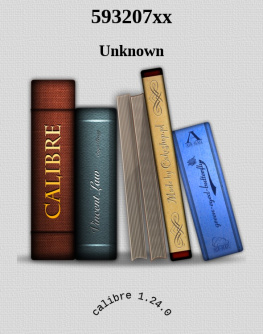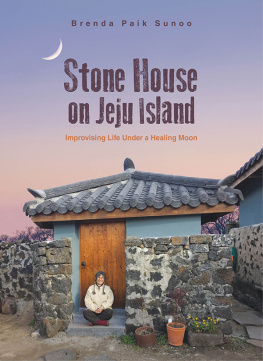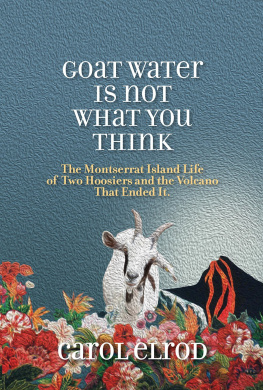This book hasbeen p ercolating in my mind for a long time. I keptdiaries of our winters on Montserrat, but didn't quite know what I was going todo with them. I was encouraged by my husband Ed and by friends in the States tofind a way to share our story.
I knew that whatha ppened to Ed and me during those four years wasvery different from what most people experience. Who, for ex ample, has sung in a choir concert with bats zipping backand forth overhead? And who has witnessed the build-up to volcanic eruptionsless than th ree miles up a mountain from home? Duringour time on Montserrat, we learned to live with less, to accept what we did notor could not have, to take joy in simple pleasures, to live close to the landand to be in sync with nature.
We have ourMontserratian and our Canadian friends to thank forthe example they set. We will always be grateful to them.
All the events inthis book really happened, but the names have been changed to protect theinnocent and, sometimes, the guilty.
INTRODUCTION
Montserrat, shap ed like a teardrop, is about ten miles long and seven mileswide at its widest point. Like many islands in the Carib bean, it is volcanic, meaning it was formed millions ofyears ago by eruptions under the sea, which eventually pushed lava upwardsuntil la nd was exposed. When my husband Ed and Ibecame acquainted with Montserrat, ordinary people on the island thought themoun tains were quiet.
The fact that Montserrat had hotspringsand tourists came for spa treatmentsdidn't bother anybody. In someareas of the island, sulfur was being extruded fromthe earth, but the general population thought this to be a boon for tourism anda curiosity, nothing more. Some scientists took another view, but theirconclusions were buried in the literatureor unheeded. The tallest mountain was Chance's Peak at 3,002 feet above sealevel. It was near the sulfur beds, which were on the Westside of Montserratsouth of the capital city, Plym outh.
The islands of the Caribbean,including St. Thomas, Antigua, Guadeloupe, Dominica ,Martinique, Barbados and Trinidad, to name some that are well-known totourists, form a curved chain leading from Puerto Rico south toward SouthAmerica. Montserrat is much less well known than the larger islands and is noteven noted on some maps.
Becau seof Montserrat's laid-back lifestyle and the lack of air traffic overhead,George Martin, the Beatles arranger and record pro ducer,built a large recording studio on the island, and the Fab Four and otherperformers came there to rehearse and record. We weretold that the Montserratians didn't pay much attention to the celeb rities in their midst and let them relax and work in peace.This studio was destroyed by Hurricane Hugo on September 17, 1989, and theGeorge Martin era came to an end.
Way back in i ts history, from perhaps 500 BC until 500 AD, Montserratwas the home of Arawak Indians, who came from South America by canoe andestablished an advanced civilization. In the 1400s, the principal indigenousIndians were the more war-like Car-ibs. Many of t heremaining Indians on the island died of diseas esbrought by Spanish explorers. Christopher Columbus, who first saw the islandduring his second voyage to the New World in 1493, named the tear-shapedCaribbean jewel "Montserrat." The reason?
The serrate d mountains reminded him of those in the vicinity of the Santa Maria deMontserrate monastery near Barcelona, Spain.
White Irish/Catholic settlers,escapees from persecution on the nearby island of St. Kitts, arrived onMontserrat in the 1600s. They either brought along orprocured slaves for their sugar and cotton plantations. Descendants of thoseslaves are the Montserratians of today. Many of the slaves took the last namesof their owners, and descendants even now have Irish surnames, such as Riley,Ryan and O'Garro. And Montserrat is called the"Other Emerald Isle," partly because of its Irish past and partiallybecause the mountains are so green.
Over time, ownership of the islandshifted back and forth be tween the French and theBritish. It was return ed to the British as part ofthe Treaty of Versailles in 1783. Although other islands in the Caribbean laterbecame independent, Montserrat voted to remain a dependency of Great Britain in1962.
Ed and I came upon this islandparadise after the hurricane. A Category 4 storm,Hurricane Hugo killed 10 people on Montserrat and caused $250 million indamage. Guadeloupe was also severely affected, and as the storm movednorthwest, so were the US Virgin Islands, Puerto Rico and South Carolina.Charleston was espe cially hard-hit.
As many as 11,000 Montserratianswere left homeless. In fact, almost all the island's buildings were damaged tosome degree. A couple of weeks after the hurricane, a Methodist minister friendasked Ed to join him and others from central an dsouthern Indiana to help rebuild houses. During his week-long stay, Ed grew tolove the smashed-up island.
He took me back for a vacation thenext year and the year after that, after which we bought a small house on theEastside of the is land. I had not seen it at the time we purchased it. Ed saw the house thefirst time when he went to sign the papers. We chose that area because that'swhere he had worked and that's where he already knew people. Nearly all of thepeople he knew were residents of Mont-se rratianvillages up the flanks of Chance's Peak, and of "Spanish Point," asubdivision down the mountain toward the Atlantic Ocean. (The Westside of theisland faces the Caribbean Sea.) Those living in Spanish Point, where ourhouse-to-be was located, were not neces sarily all people native to the Island. There were alsowhat people on the island called expatriates.
Expatriates, or "expats"on this island, meant people who weren't native to the island but chose to livethere fullor part-time. Most expats w ere white. Notmany of them lived on the Eastside of the island, but some, like us, did.
The social life of white enclaveson the Westside of the island tended to center on the Montserrat Golf Club.Some of the houses, but by no means all, were large and l uxurious. There was a lot of par tyingamong the expats in the West, not so much in the East.
Westsiders preferred to stay nearthe golf club and the capital city, Plymouth, where most of the shops were.Because the roads on the island were curvy, there we redrop-offs, animals ran loose and streetlights were almost non-existent, manyexpats didn't like to drive at night. This was one major reason why the expatsfrom the two sides of the island didn't know each other very well.
Westside subdivisions and town s were not segregated, however. Montserratians with moremoney tended to live near expats who had more money. Stratification definitelywas by class, not by race. Lower middle class and poor Montserratians lived inboth the West and the East.
Ed and I purc hased our house after seeing a video prepared by a neighborwho was acting as an agent for the seller, a Canadian wid ower in his 80s who had decided he needed to return to hishome country to be near relatives. After our initial visits to the island and o ur decision to look for a home, Ed had done a walk-throughof the home we selected before he signed the papers in February of 1992. I waseager to see it. A life completely foreign to anything we had known growing upin Indianapolis, Indiana, was about to begin.









